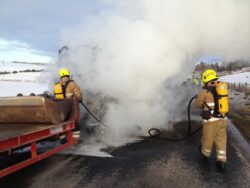Bladder Cancer Due to AFFF
Bladder cancer, a malignancy of the urinary bladder lining, poses a grave health challenge with substantial morbidity and mortality rates. Occupational hazards, particularly among firefighters, have been identified as a contributing factor to the disease's incidence. Central to this concern is exposure to aqueous film-forming foam (AFFF), a fire suppressant extensively used for combating fuel fires. AFFF contains per- and polyfluoroalkyl substances (PFAS), which are chemicals that have raised health warnings. Evidence from scientific studies suggests a correlation between PFAS exposure from AFFF and the development of bladder cancer, implicating these compounds in carcinogenic processes.

Key Takeaways
- Firefighters have a 9% higher risk of developing cancer, with bladder cancer being a major concern due to the use of AFFF.
- AFFF contains PFAS, a group of over 5,000 toxic chemicals, which can lead to changes in bladder tissue cells and increase the risk of bladder cancer.
- PFOA and PFOS, two common PFAS chemicals, can be found in human blood, breast milk, umbilical cord blood, and urine, and can enter ecosystems and accumulate in the bladder.
- Military personnel exposed to PFAS at military facilities may be at an increased risk of bladder cancer, as PFAS contamination has been found in wells around these facilities.
Bladder Cancer Statistics
Bladder cancer statistics indicate that over 81,000 individuals were projected to receive a diagnosis by the end of 2022, with a considerable portion of these cases linked to exposure to Aqueous Film-Forming Foam (AFFF) in firefighting environments. In the realm of bladder cancer prevention, it is imperative to address the occupational hazards that contribute to the disease's etiology. Enhanced firefighter safety precautions are necessitated to mitigate the insidious health effects of AFFF exposure. Through the implementation of rigorous decontamination protocols and the adoption of PFAS-free firefighting alternatives, the incidence of carcinogenesis attributable to these environmental toxins can be curtailed. Vigilance in exposure reduction represents a critical vector in the prophylaxis against urothelial carcinoma among firefighting personnel.
Firefighters at Risk

The increased incidence of bladder cancer in firefighters has been linked to their frequent exposure to Aqueous Film-Forming Foams (AFFF) containing carcinogenic per- and polyfluoroalkyl substances (PFAS). These substances are integral in firefighting but have been identified as a serious threat to firefighter health. Ensuring cancer prevention among firefighters necessitates addressing the risks associated with PFAS exposure.
| Firefighter Health | Cancer Prevention |
|---|---|
| PFAS blood levels | Regular screening |
| Use of AFFF | Protective gear |
| Risk assessments | Exposure limits |
| Health surveillance | PFAS alternatives |
A multi-faceted approach is vital, involving regular health surveillance, use of PFAS-free alternatives, and stringent exposure controls. These measures are paramount in safeguarding those who protect our communities from the insidious health effects of PFAS.
Understanding AFFF
Concerning Aqueous Film-Forming Foams (AFFF), these firefighting agents are instrumental in extinguishing fuel fires but contain PFAS, which are linked to an array of health issues including an increased risk of bladder cancer. The per- and poly-fluoroalkyl substances (PFAS) within AFFF are resistant to environmental degradation, thus persisting in the environment and potentially contaminating drinking water sources.
- PFAS exposure in drinking water: Due to their chemical stability, PFAS can leach into groundwater, posing a risk to communities through long-term exposure.
- AFFF alternatives: Research and development are underway to create fluorine-free foams that reduce environmental and health impacts.
- Health implications: Chronic exposure to PFAS compounds has been correlated with various cancers, including bladder cancer, necessitating urgent attention to AFFF management and use.
Toxicity of PFAS
Amidst the mounting evidence of health risks, the toxicity of PFAS compounds emerges as a critical factor in understanding their link to bladder cancer through AFFF exposure. Perfluoroalkyl and polyfluoroalkyl substances (PFAS) are a class of synthetic organofluorine chemical compounds with the potential for widespread ecotoxicity and bioaccumulation. PFAS health effects are profound, with these substances disrupting endocrine function and potentially inducing carcinogenesis upon chronic exposure. PFAS exposure routes are numerous, including ingestion, dermal contact, and inhalation, with AFFF serving as a notable source of occupational contact for firefighters. Research delineates the mechanisms by which PFAS may facilitate oncogenic transformation in urothelial cells, implicating these compounds in the etiopathogenesis of bladder malignancies.
Medical Evidence Link
Recent studies provide a compelling medical evidence link between PFAS exposure and the incidence of bladder cancer in individuals frequently handling AFFF. The pathophysiological mechanisms underlying this association are increasingly understood, with PFAS inducing urothelial cytotoxicity and genomic instability. Enhanced absorption and bioaccumulation of these substances in bladder tissue raise oncogenic risk profiles.
- Epidemiological data correlates elevated PFAS serum levels with heightened bladder cancer diagnoses.
- Oncological research identifies PFAS as a disruptor of tumor suppressor gene function, facilitating neoplastic processes.
- Innovations in treatment options are being informed by the molecular pathways affected by PFAS, guiding targeted therapies.
This medical evidence necessitates a paradigm shift in monitoring and managing health outcomes for those with occupational AFFF exposure.
PFAS Research Findings
Numerous studies have confirmed the carcinogenic potential of PFAS, particularly bladder cancer, by demonstrating their persistence in the environment and their ability to disrupt cellular processes. Ongoing toxicological research elucidates the multifaceted PFAS health effects, including immunotoxicity, endocrine disruption, and tumor genesis. Epidemiological data correlates PFAS exposure, via contaminated water, occupational contact, and consumer products, with heightened bladder cancer incidence. Investigations reveal that PFAS exposure routes contribute to bioaccumulation and biomagnification, exacerbating the risk of oncogenesis. The molecular mechanisms underpinning PFAS-induced carcinogenesis involve genotoxicity, oxidative stress induction, and modulation of cell proliferation and apoptosis pathways. These findings are critical for informing public health policies, occupational safety protocols, and clinical interventions aimed at mitigating PFAS-related health risks.
Firefighting Foam Dangers

Several firefighting foams containing AFFF are now recognized as a health hazard due to their high concentrations of carcinogenic PFAS. These substances are not only acutely toxic but also possess characteristics that contribute to long-term health effects, including cancer, immune system disruption, and endocrine interference.
- Carcinogenicity: PFAS compounds have been linked to the development of various cancers, including bladder cancer in firefighters.
- Bioaccumulation: Due to their persistence in the environment, PFAS accumulate in the human body, leading to chronic exposure.
- Firefighting foam alternatives: Efforts are underway to develop PFAS-free foams that reduce occupational and environmental health risks.
In the interim, minimizing exposure through the use of firefighting foam alternatives and taking protective measures is imperative for safeguarding firefighter health.
Occupational Cancer Studies
Addressing the link between AFFF and cancer, occupational studies have identified a definitive correlation between exposure to firefighting foams containing PFAS and an increased incidence of bladder cancer in firefighters. These studies underscore the importance of robust occupational cancer prevention strategies. Epidemiological research, utilizing biomarkers and longitudinal analysis, has reinforced the necessity for enhanced firefighter safety measures. Consequently, risk mitigation protocols, including the use of PFAS-free foams and improved personal protective equipment, have been advocated. Systematic screening for early detection, alongside comprehensive occupational health surveillance programs, is being integrated into firefighter health regimens. These interventions are critical in reducing the burden of carcinogenic exposure from AFFF and safeguarding the long-term health of firefighting personnel.
Turnout Gear Contamination
In the wake of occupational cancer studies, attention has shifted to the contamination of firefighter turnout gear with PFAS, a critical factor in the elevated cancer risks faced by firefighting professionals. The persistent nature of per- and polyfluoroalkyl substances (PFAS) poses substantial challenges for decontamination protocols. Advanced methodologies are being explored to enhance the efficacy of turnout gear decontamination, aiming to reduce PFAS absorption through dermal contact.
- Implementation of rigorous turnout gear decontamination processes to minimize PFAS residue.
- Development of PFAS-free protective materials for manufacturing firefighter turnout gear.
- Adoption of comprehensive protective measures, including post-exposure hygiene practices, to limit PFAS exposure.
These strategies underscore a paradigm shift towards strengthening the defense against occupational hazards and safeguarding the long-term health of firefighting personnel.
Military Base Pollution

Turnout gear contamination at military installations has led to considerable PFAS soil and groundwater pollution, raising concerns about increased bladder cancer risks among service members. Military base contamination has been extensively documented, with perfluoroalkyl and polyfluoroalkyl substances (PFAS) identified as pervasive environmental contaminants. These compounds exhibit extreme persistence, and bioaccumulation potential, and are characterized as endocrine disruptors. Epidemiological studies correlate PFAS exposure with a multitude of adverse health effects, including carcinogenicity, with a focus on renal and bladder tissues due to their role in PFAS excretion. Service personnel in contact with PFAS-contaminated Aqueous Film Forming Foam (AFFF) may absorb these toxins, leading to bioaccumulation and subsequent oncogenesis. The health effects of PFAS necessitate rigorous environmental remediation and medical monitoring to mitigate the carcinogenic risk within military populations.
Environmental PFAS Impact
The contamination of ecosystems by PFAS through AFFF not only poses risks to human health but also has far-reaching consequences for environmental integrity and wildlife safety. Persistent, bioaccumulative, and toxic properties of PFAS lead to ecological disruptions, emphasizing the need for stringent environmental regulations. Public health concerns arise from the biomagnification of these compounds in food chains, affecting species diversity and ecosystem functions.
- Bioaccumulation: PFAS accumulates in the tissues of aquatic and terrestrial organisms, leading to toxic effects.
- Ecotoxicological Effects: PFAS exposure can result in reproductive, developmental, and systemic toxicity in wildlife.
- Regulatory Challenges: Implementing and enforcing environmental regulations to limit PFAS release and mitigate its impact remains complex due to the chemicals' widespread use and persistence.
Signs of Bladder Cancer
Several early indicators of bladder cancer, such as blood in the urine (hematuria), frequent urination, and pelvic pain, may be initially overlooked as common urinary issues but warrant further investigation due to the potential connection with AFFF exposure. Hematuria, particularly, is a cardinal symptom that necessitates prompt attention for diagnosing bladder cancer. Urothelial carcinoma, the predominant histological variant of bladder cancer, often manifests with these nonspecific symptoms. Diagnostic modalities such as cystoscopy and urinary cytology are pivotal in the detection of malignant cells. Furthermore, imaging techniques like CT urography play a crucial role in the staging of the disease. Upon confirmation, treatment options are evaluated, ranging from surgical intervention, intravesical therapy, to systemic chemotherapy and immunotherapy, depending on the tumor grade and stage.
Misdiagnosis Challenges
Misdiagnosis challenges in bladder cancer, often stemming from its non-specific symptoms, can lead to delayed or incorrect treatment for firefighters exposed to aqueous film-forming foam (AFFF). These challenges can compromise the prognosis and management of the disease, necessitating a rigorous diagnostic approach.
- Hematuria Overlap: Common urinary symptoms like hematuria may be attributed to benign conditions, delaying oncological evaluation.
- Cystoscopic Limitations: Subtle malignant changes may be overlooked during cystoscopy, especially in early-stage carcinomas.
- Marker Misinterpretation: Urinary biomarkers indicative of malignancy can be misinterpreted, leading to underestimation of the neoplastic process.
The differential diagnosis must be meticulously conducted to mitigate these misdiagnosis challenges, with an emphasis on the occupational history that includes AFFF exposure.
Legal Recourse Options

Firefighters' legal options for pursuing compensation for bladder cancer related to AFFF exposure include filing personal injury lawsuits and workers' compensation claims. Personal injury litigation may target manufacturers of AFFF, alleging negligence in failing to warn about the carcinogenic potential of PFAS compounds. Plaintiffs can present epidemiological evidence linking PFAS exposure to oncogenic transformation within urothelial cells. Additionally, bladder cancer misdiagnosis claims may arise when initial clinical assessments erroneously attribute symptoms to benign urological conditions, delaying crucial oncological intervention. In such cases, legal action can seek recompense for the detrimental impact of diagnostic inaccuracies. Workers' compensation may provide an alternative pathway, although proving causation within this context necessitates a rigorous demonstration of occupational PFAS exposure as the etiological factor for the malignancy.
Seeking Compensation
For individuals diagnosed with bladder cancer linked to AFFF exposure, pursuing compensation is a critical step toward addressing the financial and emotional burdens of the disease. Determining compensation eligibility necessitates a comprehensive review of clinical history, occupational exposure, and the correlation of PFAS biomarkers to malignancy. Legal representation is paramount in navigating the complex litigation framework to secure reparations for harm endured.
- Evaluation of exposure history and medical documentation to establish a causal link
- Selection of competent legal counsel with proficiency in toxic tort litigation
- Strategic litigation to pursue damages for medical costs, loss of income, and non-economic suffering
An adept legal team versed in environmental law and the pathophysiology of AFFF-induced carcinogenesis is crucial for a successful compensation claim.
Frequently Asked Questions
What Other Occupations, Aside From Firefighters and Military Personnel, Are at Heightened Risk for Bladder Cancer Due to PFAS Exposure From AFFF?
Occupations beyond firefighting and military roles are susceptible to heightened bladder cancer risks due to PFAS exposure from Aqueous Film-Forming Foams (AFFF). Specifically, industrial workers and airport staff, often navigating a labyrinth of hazardous substances, might encounter these pernicious chemicals. Their professional terrain, rich with technical complexities, demands stringent safety protocols to mitigate the insidious health threats posed by PFAS, a critical consideration within occupational health discourse.
How Can Consumers Reduce Their Risk of PFAS Exposure in Everyday Household Products That Might Contribute to Bladder Cancer Risk?
To minimize PFAS exposure from household products, consumers should rigorously scrutinize product labels for PFAS-free claims and opt for items without these substances. Implementing water filtration systems specifically designed to remove PFAS compounds can greatly reduce their presence in drinking water. Such proactive measures are essential in mitigating potential health risks associated with these persistent environmental pollutants.
Are There Any Ongoing or Planned Public Health Initiatives Aimed at Monitoring or Reducing PFAS Exposure in Communities Located Near Fire Training Facilities?
Public health initiatives are in development to address PFAS contamination near fire training facilities. These initiatives prioritize community education on exposure risks and promote legislation advocacy for stricter environmental regulations. Such public health strategies are informed by epidemiological data and seek to employ technical remediation and surveillance measures to mitigate PFAS dissemination and accumulation in local ecosystems, ultimately safeguarding community health from potential toxicological consequences.
What Are the Potential Impacts of PFAS Exposure on Wildlife and How Might This Affect Human Health Indirectly, Particularly Concerning Bladder Cancer?
PFAS exposure can result in substantial ecosystem disruption, primarily through wildlife biomagnification. As these persistent chemicals ascend the trophic levels, they concentrate on organisms, potentially altering their biological functions. This environmental persistence poses indirect health risks to humans by contaminating food sources. The cumulative effect may contribute to an increased incidence of diseases, including potential implications for the development of conditions like bladder cancer through long-term dietary exposure to these contaminants.
How Can Individuals Who Suspect PFAS Exposure From AFFF but Have No Documented Medical History or Proof of Direct Contact Seek Help or Participate in Studies?
Individuals concerned about potential PFAS exposure, despite lacking medical documentation or evidence of direct contact, can explore legal avenues for recourse. Community outreach programs may provide access to relevant studies and resources. Engaging with such initiatives can facilitate the gathering of scientific data, fostering a collective understanding of PFAS implications. This approach combines clinical expertise with technical terminology to navigate the complexities of exposure and potential health outcomes.




